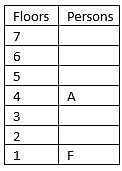RRB NTPC (CBT I) Full Mock Test - 2 - RRB NTPC/ASM/CA/TA MCQ
30 Questions MCQ Test - RRB NTPC (CBT I) Full Mock Test - 2
A student’s marks were wrongly entered as 93 instead of 39. Due to that, the average marks for the class got increased by 1. Find the number of students in the class.
| 1 Crore+ students have signed up on EduRev. Have you? Download the App |
Consider the question given and decide which of the following statement(s) is/are sufficient to answer the question.
Find the age of the mother from the given statements.
Statements:
I: Mother’s age is 10 years more than her son's age.
II: Son’s age is 24 years more than the daughter's age.
3 R # 2 A $ K 5 % T 7 & N Y ÷ X B / L Q @ 1
If the second half of the above series is reversed, then using the new series, identify the missing term-
A%T : 52/ :: QY/ : ________
The All India Forward Bloc was established by which of the following national leaders together with his followers in 1939, during British rule in India?
Which country topped the Human Development Index (HDI) in the 2023–24 Human Development Report?
A, B and C are sitting on a bench facing south. D, E and F are sitting on a parallel bench facing north. D is at one of the ends and to the immediate left of F. B is facing D. C is to the right of A. Who is facing A?
Dhupgarh peak is the highest point of which of the following States of India?
Select the option figure in which the given figure is embedded. (Rotation is NOT allowed).

Match List-I with List-II and select the correct answer from the codes given below :

Which one of the following place is the confluence of the river Alakhnanda and the Bhagirathi?
"Samudrayaan", India’s first manned mission to explore the deep ocean, is aimed
In fractions  and
and  , largest and smallest fractions are respectively
, largest and smallest fractions are respectively
Find the median of the following data.
15, 30, 20, 10, 25, 35, 18, 21, 28
Seven persons A, Q, E, F, L, M and C live on 7 floor building numbered as 1 to 7th floor from bottom to top. Bottom floor numbered as floor 1 and its above floor numbered as floor 2 and so on. Topmost floor numbered as floor 7. A lives on the 4th floor. Two persons live between A and F. M lives just above E. F does not live on the top floor. Q lives on the 2nd floor. L is not an immediate neighbour of Q and does not live on the top floor. Who lives on the top floor?
An object requires a force of 100N to achieve the acceleration ‘a’. If the mass of the object is 500 kg what will be the value of ‘a’?
 km/h, then what will be the value of x?
km/h, then what will be the value of x?


































